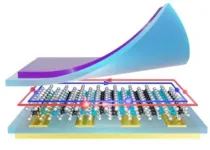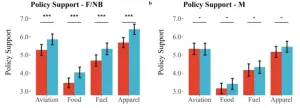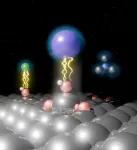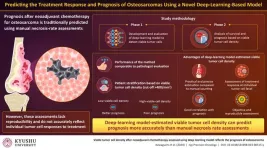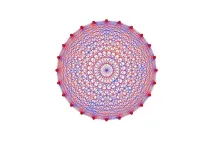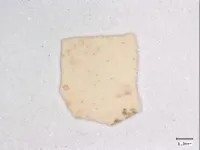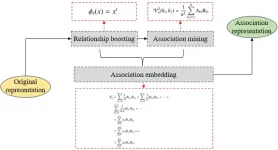(Press-News.org) Is the view from your doorstep mostly trees and sky or buildings and grass? The answer could influence your cardiovascular health, according to a study presented at the American College of Cardiology’s Annual Scientific Session. Using an analysis of Google Street View images powered by machine learning, researchers found people living in surroundings rich in sidewalks, trees and clear sky saw a significantly lower risk of major adverse cardiac events.
“A lot of research has shown that environmental factors strongly affect our health. If we can find a way to stratify this risk and provide interventions before cardiovascular events happen, then we could save a lot of lives,” said Zhuo Chen, PhD, a postdoctoral researcher at Case Western Reserve University and University Hospitals Health System in Cleveland and the study’s lead author. “Our study shows that with advanced computer vision algorithms and AI, we now have the ability to quantify the built environment more effectively and efficiently. If we can assess the individual’s risk at a granular level, we could provide more personalized interventions.”
The study is part of a growing body of research investigating how greenspace and the built environment influences cardiovascular risk. Previous studies have used a variety of approaches to quantify environmental features, with mixed results. By combining Google Street View images with robust segmentation methods for analyzing “vertical greenspace”—the view along the skyline and not only on the ground—this study offers a more nuanced and granular perspective on the environment at the level of individual streets rather than averaging across entire counties or ZIP codes.
The researchers used a machine learning algorithm trained to distinguish between trees, grass, sky, sidewalks, buildings and roads to analyze Google Street View images of the residences of nearly 50,000 study participants. Participants were part of a program that provides free and low-cost coronary artery calcium tests (a non-invasive screening method to assess heart disease risk), mostly in northeastern Ohio.
Over a median follow-up period of about 27 months, approximately 2,000 of the patients had experienced a major adverse cardiovascular event, such as a heart attack, stroke or death from heart disease. By analyzing participants’ built environment, researchers found that people living in areas with more sidewalks were 9% less likely to suffer major cardiac events than people living in places with fewer or no sidewalks. In addition, people living in places that scored highly for vertical greenspace—trees and clear sky—were 5% less likely to suffer these events than people in areas that scored low for this metric. These associations were independent from each other.
To account for other factors known to influence heart health, the researchers adjusted the models for age, race, sex, social vulnerability, median household income, fine particle air pollution, noise and cardiovascular risk factors, such as high blood pressure, high cholesterol and diabetes.
“The method and the data source that we’re using here is cheap, open source and publicly available,” Chen said. “It can assess anywhere there are Google Street View cars on the road and really provide a refined metric of the environment.”
The results showed no association between the presence of grass and the risk of cardiovascular events, further bolstering the results of previous studies that found a closer association between trees and cardiovascular health than just grass. However, Chen said that trees alone were not found to have an association with cardiovascular outcomes. Rather, it is the combination of trees and clear sky that together appeared to be a better indicator of vertical greenspace. To refine this metric, the researchers incorporated depth information into the machine learning algorithm.
The study design did not allow for the determination of a causal relationship between environmental features and heart disease, Chen said. It also did not include data on residents’ physical activity or travel behaviors, limiting the ability of researchers to directly examine the mechanisms linking greenspace, walkability and cardiovascular outcomes. In addition, researchers said the cohort consisted mostly of individuals in northeast Ohio, which may limit generalizability of the findings to other areas.
Nevertheless, by refining methods for assessing environmental features at scale, Chen said the work can offer useful insights for addressing an important public health issue at the intersection of environment and personal health.
“It doesn’t necessarily mean that if we plant more trees or build more sidewalks, we’ll reduce cardiovascular risk,” Chen said. “But it still gives us preliminary suggestions and indicators that can help us become aware of ways to change behaviors or neighborhood planning in the future to [potentially] lower cardiovascular risk.”
Chen will present the study, “Residential Vertical Greenspace and Sidewalks Impacts on Cardiovascular Risk: Insights from Deep Learning-Enhanced Google Street View,” on Sunday, April 7, 2024, at 3:15 p.m. ET / 19:15 UTC in Hall B4-5.
ACC.24 will take place April 6-8, 2024, in Atlanta, bringing together cardiologists and cardiovascular specialists from around the world to share the newest discoveries in treatment and prevention. Follow @ACCinTouch, @ACCMediaCenter and #ACC24 for the latest news from the meeting.
The American College of Cardiology (ACC) is the global leader in transforming cardiovascular care and improving heart health for all. As the preeminent source of professional medical education for the entire cardiovascular care team since 1949, ACC credentials cardiovascular professionals in over 140 countries who meet stringent qualifications and leads in the formation of health policy, standards and guidelines. Through its world-renowned family of JACC Journals, NCDR registries, ACC Accreditation Services, global network of Member Sections, CardioSmart patient resources and more, the College is committed to ensuring a world where science, knowledge and innovation optimize patient care and outcomes. Learn more at ACC.org.
###
END
Chestnut Hill, Mass (4/2/2024) – Dual topological phases have been discovered in an intrinsic monolayer crystal, a finding that reveals new and unique rule-bending properties in a quantum material, an international team of scientists led by Boston College physicists reported recently in the online version of the journal Nature.
The discovery of a dual topological insulator introduces a new method for creating topological flat minibands through electron interactions, which offer a promising platform for exploring exotic quantum phases and electromagnetism, ...
Brussels, Belgium, and San Francisco, United States - The Public Library of Science (PLOS) and the European Council of Doctoral Candidates and Junior Researchers (“Eurodoc”), today announced a strategic partnership between the organizations to increase awareness of Open Science, its principles, and its implementation into research practices.
“In addition to supporting researchers, we also strive to support the implementation of Open Science principles and increase the adoption of ...
Investments in mitigating climate change in many cases benefit future generations more than those alive today. However, initial costs must be borne by those living now, so many climate mitigation policies rely on some level of intergenerational altruism for support. To investigate the strength and shape of intergenerational altruism, Gustav Agneman and colleagues asked Swedish study participants to engage in an experimental task in which they allocated fictional resources across generations, after being told how many descendants they might be expected to have in the next 250 years. On average, participants allocated most of the resources to the present generation, and fewer and ...
The pursuit of carbon neutrality drives the exploration of clean energy sources, with hydrogen fuel cells emerging as a promising avenue. In these cells, hydrogen undergoes an electrochemical reaction with oxygen to produce electricity and water. Also, the reverse of this process, called electrolysis, can be used to split the abundantly available water to produce hydrogen and oxygen. These two technologies can work in tandem to provide a clean and renewable source of energy. A pivotal element in these two technologies is the platinum (Pt) electrode.
Hydrogen fuel cells consist of two electrodes: an anode and a cathode, with an ...
Fukuoka, Japan - Researchers at Kyushu University have developed and validated a machine-learning model that can accurately evaluate the density of surviving tumor cells after treatment in pathological images of osteosarcoma—the most prevalent malignant bone tumor. The model can assess how individual tumor cells respond to treatment and can predict overall patient prognosis more reliably than conventional methods.
Surgery and chemotherapy have significantly improved the outcomes of patients with localized osteosarcoma. However, patients with advanced metastatic disease (the stage where cancerous cells have spread to distant tissues) have a low survival rate. ...
All-solid-state lithium-ion (Li-ion) batteries with solid electrolytes are non-flammable and have higher energy density and transference numbers than those with liquid electrolytes. They are expected to take a share of the market for conventional liquid electrolyte Li-ion batteries, such as electric vehicles. However, despite these advantages, solid electrolytes have lower Li-ion conductivity and pose challenges in achieving adequate electrode-solid electrolyte contact. While sulfide-based solid electrolytes are conductive, they react with moisture to form toxic hydrogen disulfide. Therefore, there's ...
A new study found that during the pandemic pediatric emergency departments (EDs) saw more children and adolescents who needed a psychiatric admission, as well as an increase in severe conditions, such as bipolar disorder, schizophrenia and substance use disorders. The higher demand for a psychiatric inpatient bed often exceeded availability, resulting in over 12-hour stays in the ED awaiting admission for nearly 20 percent of children with mental health emergencies in 2022, up from 7 percent before the pandemic. Findings were published in Academic Emergency Medicine.
“Our data shows that pediatric emergency departments saw more severe mental health presentations during the pandemic, ...
We’ve all been there: staring at a math test with a problem that seems impossible to solve. What if finding the solution to a problem took almost a century? For mathematicians who dabble in Ramsey theory, this is very much the case. In fact, little progress had been made in solving Ramsey problems since the 1930s.
Now, University of California San Diego researchers Jacques Verstraete and Sam Mattheus have found the answer to r(4,t), a longstanding Ramsey problem that has perplexed ...
Chickens are one of the most economically important animals in the world today. However, the story of their origins and dispersal across the ancient world is still poorly understood. In fact, new archaeological techniques have recently led to the recognition that many finds of bones previously thought to represent early chickens in fact belonged to wild birds. Now, in a new publication, an international team of archaeologists, historians, and biomolecular scientists present the earliest clear evidence for the raising of chickens for egg production, and argue that the loss of seasonal egg laying was the main driver for the dispersal of domestic chickens across Eurasia and northeast Africa.
Using ...
Association in-between features has been demonstrated to improve the representation ability of data. However, the original association data reconstruction method may face two issues: the dimension of reconstructed data is undoubtedly highly than that of original data, and adopted association measure method does not well balance effectiveness and efficiency.
To solve the problems, a research team led by Yuhua QIAN published their new research on 12 Mar 2024 in Frontiers of ...
